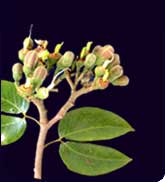For the record, while I do not believe it is
fair, I waived my right
to make medical claims . . . because (1) I was unwilling to undergo
the types of tests that I was told would be required: lumbar
punctures and other dangerous and invasive procedures that the
insurance company would have used to intimidate me, and (2) I
was committed to getting well rather than subscribing to the
conventional wisdom, which to the extent that there is any understanding
at all of mold, holds the view that damage
to the central nervous system is irreversible. Therefore, I feel free to discuss
my medical issues because I know my story will bring hope to
many others.

If you started here rather than
on the previous page, you should go
back because it is there
that the major issues affecting the central nervous were discussed. Moreover,
from what you will see there, you realize that this is the part
of the mold illness that I have managed most successfully. In
fact, I am convinced that if I can either fix this house or move,
I would eventually recover everything except my lost time and
pets.
Toxicity and Odor
This symptom is not listed in very
many references on mold, but to the extent that mold is toxic,
the body uses a lot of resources for dealing with the mold metabolites
and mycotoxins. I believe there are basically three types
of physiological conditions related to these toxins.
- There
is the gas of the active spores. These gases give
rise to the familiar musty odors, but there is a chemical
odor, sort of acrid, that is far less well understood. This
can be exceedingly dangerous. It affects the nostrils,
sinus passages, and lungs; but if the mold is inhaled and
it lodges in the body, it can affect any tissue in the
body. It
is broadly recognized that different molds have preferences
for specific bodily systems, but since mold is essentially
a composter, it eats what it can and then excretes into
the body. The gases and metabolites of this process are
toxic.
- Secondly, there is the mold, actually both
spores and their complex system of nutrient supply entailing
the generation of hyphae (and
mycelia.) These are irritating and often also toxic. The
hyphae secretes enzymes and acids. This also is a complex
field of study, but since the body wages a battle for survival,
there is some die off, not just of host tissue, but also enemy
molds. Getting rid of this debris taxes the eliminatory
system, kidneys, and skin — because the skin is the largest
organ of elimination the body has.
- Lastly, because the body is burdened by all
this extra work, it uses various back up mechanisms for self-defense. These
include fluid retention for the purpose of diluting toxins. This
can result in weight gain and lymphatic swelling. Another
is to use fat to buffer the toxins, meaning that weight loss
could precipitate a toxic crisis. Of course, some mold is attacked
by white blood cells. These often perish in the battle
so there is some congestion and toxicity stemming from sudden
death of the body's most valiant defenders.
Because of the toxicity, I found an usual
odor emitting from practically every pore in my body but
most obnoxious under my arms. However, it was coming
out of my nostrils and skin, and it gave my waste products
a strange odor. I could almost use this odor as a measurement
of the extent of environmental havoc and internal stress.
Quite by accident, I stumbled on the fact
that this odor disappears almost completely after eating
even a very small amount of asparagus. Then, as fate
would have it—and, I believe fate has played a significant
role in bringing people into my life at critical times—I
met a man who told me that mold does not really activate
because of moisture but when it smells ammonia. Of
course, ammonia is a by-product of many metabolic processes. I
speculated that there is something in asparagus that converts
ammonia to something less hostile to our sensitivities. More
importantly, I found that even very small amounts, like one
or two pieces in a soup, are just as effective as a big meal
of nothing but asparagus. Moreover, I think the Ayurvedic
rasayana herb, shatavari, has the same properties. It
is an herb famous for its benefits to the female reproductive
system and it belongs to the asparagus family. I was
able to eliminate the pungent, chemical odor completely by
relying on asparagus and shatavari.
Brown Patches
These patches began to appear rather late,
I think because my body was so stressed that the normal eliminatory
processes were unable to handle the burden. These are
often referred to as "liver spots" but in my case, they were
appearing on my face, mainly near the temples where there
is very delicate lymphatic circulation and obviously also
overload. I applied various antifungal extracts and
N-tense Topical (because, at first, I thought these may be
malignant.) They disappear, but wherever the air quality
is really bad, they come back. Frankly, I did not expect
to have decent looking skin ever again. I thought I
was heading for a devastating old age with countless complaints
and an ugly complexion.
Skin Tags
While not perhaps as threatening as singeing
vapors, these skin tags were super annoying because they
appeared in all the nice moist places where skin contacts
skin: behind the knees, inside the elbow, under my
arms, and on my eyelids. All of the tags on my legs
and arms vanished when I started using jatobá. All
but one disappeared under my arms, and the ones on my left
eyelid shrank a lot, but the ones on my right eyelid are
still annoying. Because they responded to the use of
jatobá and later Myco +, I am certain they are related to
mold.
Weight Gain
I have had zero success thus far with weight
loss. I believe I will only be able to address this
when the house is remediated properly and the stress is over
or when I move. Sorry, I wish I had better news.
Ingrid Naiman
23 November 2005
Continued,
allergic reactions 
Please
note: this section of the site is divided
into three main parts: allergies, immunity,
and toxicity. This
site is very new and the pages are going up as fast as
I can write them. To stay informed of new posts,
please subscribe to the site.




